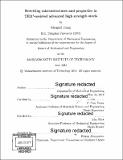Resetting microstructures and properties in TRIP-assisted advanced high strength steels
Author(s)
Jiang, Menglei (Scientist in mechanical engineering) Massachusetts Institute of Technology
DownloadFull printable version (7.918Mb)
Other Contributors
Massachusetts Institute of Technology. Department of Mechanical Engineering.
Advisor
C. Cem Tasan.
Terms of use
Metadata
Show full item recordAbstract
Metals are widely used structural materials in automotive, packaging, construction, and machines. Driven by demands to decrease greenhouse gas emissions, the reuse, re-forming, and re-manufacturing of metals draws great attention. However, current processes such as mechanical joining, welding, coating, etc. have key practical and theoretical limitations. Recently, a new reuse strategy is proposed, which aims to reset the microstructures of materials to maintain performance and increase lifetime. We refer to alloys that demonstrate this capability as resettable alloys. One resettable alloy is the transformation-induced plasticity-maraging (TRIP-maraging) steel. However, current resettable TRIP-maraging steels require long and unfeasible resetting treatments. The limit of resetting kinetics has not been reached and the microstructure resetting mechanism has not been fully understood. Here we focus on providing a deeper understanding of the resetting mechanism in TRIP-maraging steel, such as the effects of composition and pre-strain, to increase the kinetics of the underlying transformations. This study demonstrates that with proper microstructure design, the resetting process could be completed within minutes following a critical level of deformation.
Description
Thesis: S.M., Massachusetts Institute of Technology, Department of Mechanical Engineering, 2018. Cataloged from PDF version of thesis. Includes bibliographical references (pages 53-57).
Date issued
2018Department
Massachusetts Institute of Technology. Department of Mechanical EngineeringPublisher
Massachusetts Institute of Technology
Keywords
Mechanical Engineering.